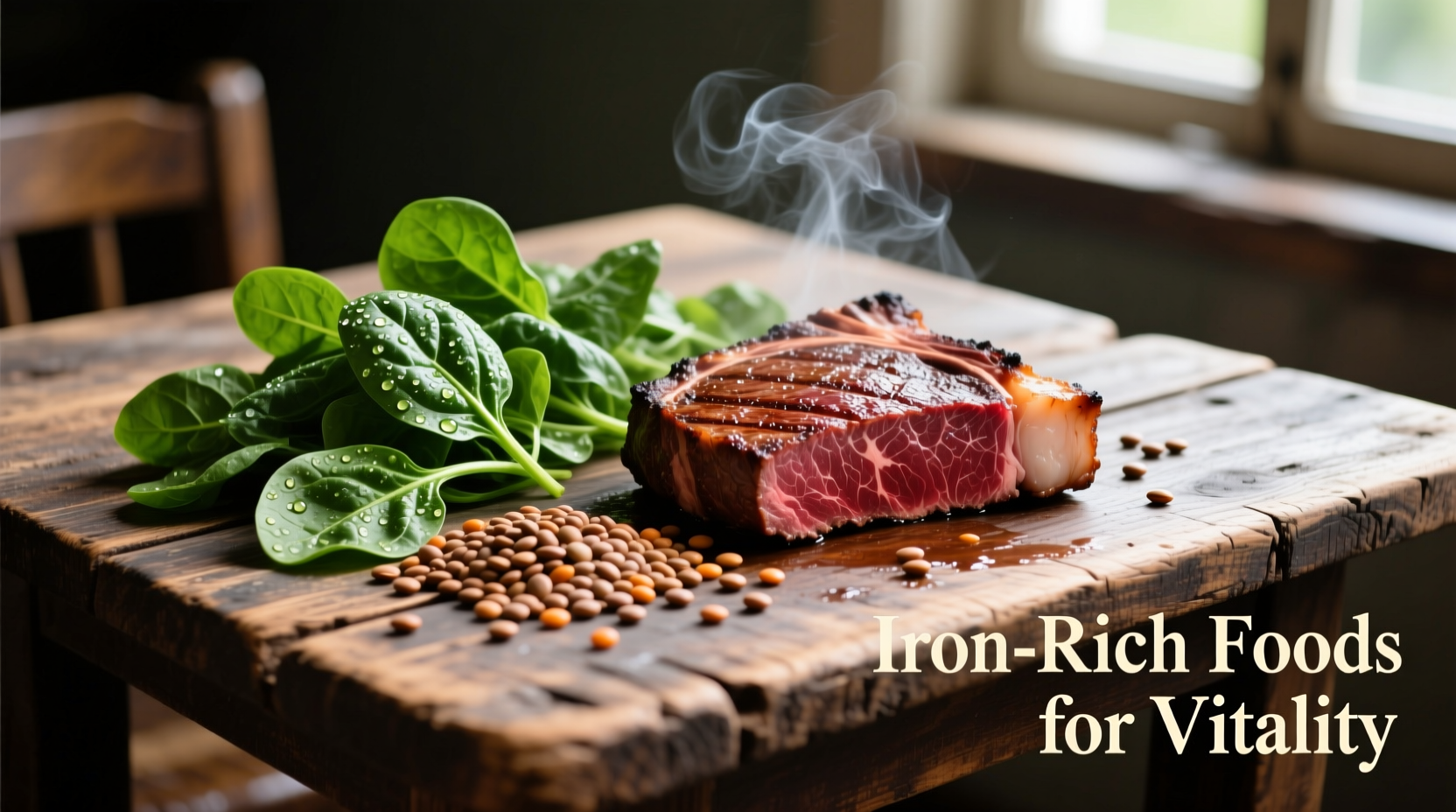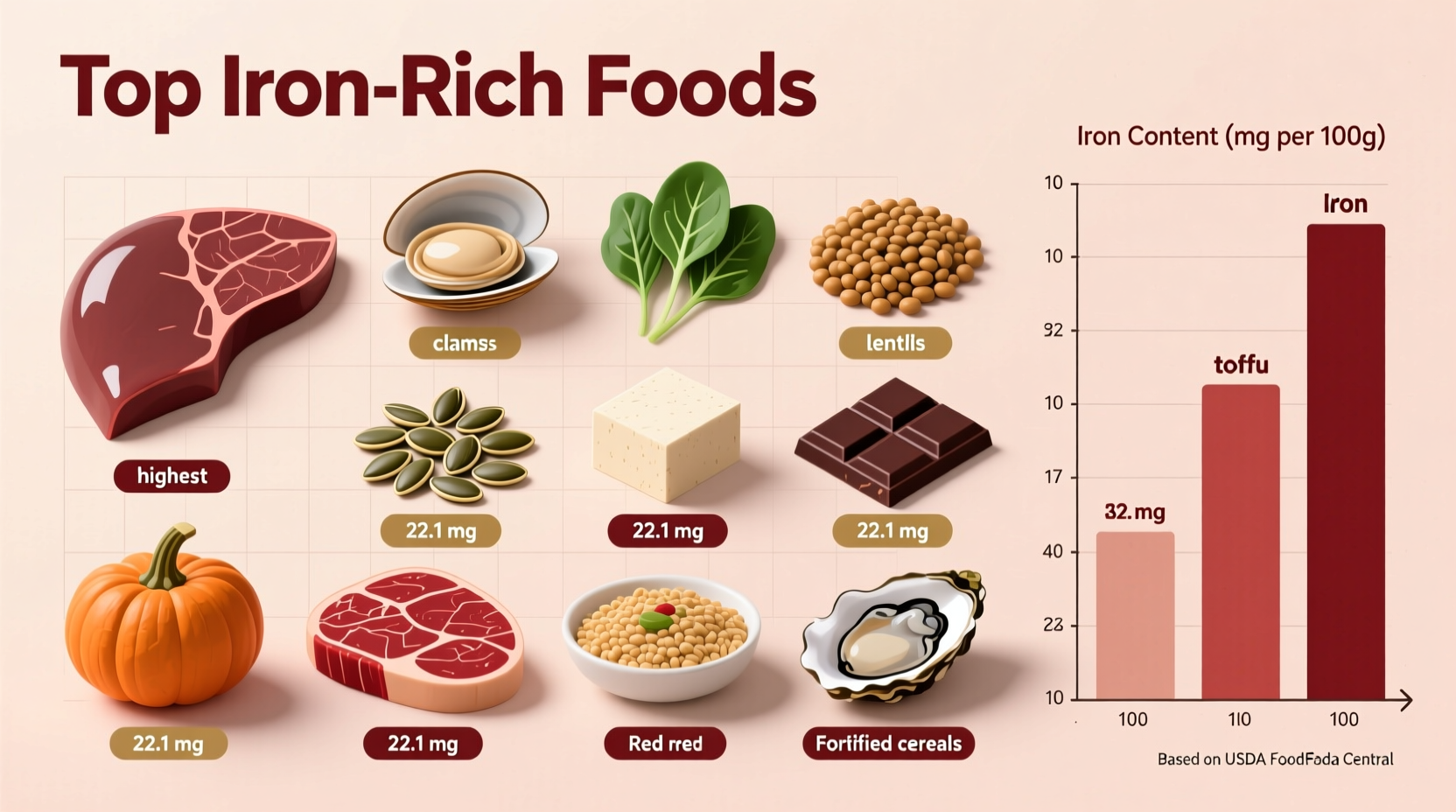The top iron-rich foods include organ meats (particularly liver), shellfish like oysters and clams, red meat, legumes, fortified cereals, spinach, and pumpkin seeds. Animal-based heme iron sources offer 15-35% absorption rates, while plant-based non-heme iron provides 2-20% absorption. Combining non-heme iron foods with vitamin C-rich ingredients can significantly boost absorption.
Iron deficiency affects over 1.2 billion people worldwide, making it the most common nutritional deficiency globally according to the World Health Organization. Whether you're managing anemia, following a plant-based diet, or simply optimizing your nutrition, knowing which foods deliver the highest iron content is essential for maintaining healthy blood function and energy levels.
Immediate Iron Boosters: Your Top Food Choices
When you need iron fast, these foods deliver the highest concentrations per serving. Understanding the difference between heme and non-heme iron sources helps you maximize absorption based on your dietary preferences.
| Food (3 oz serving) | Iron Content (mg) | Iron Type | % Daily Value |
|---|---|---|---|
| Liver (beef) | 5.2 | Heme | 29% |
| Oysters | 4.5 | Heme | 25% |
| Fortified breakfast cereal | 18.0 | Non-heme | 100% |
| Pumpkin seeds | 2.5 | Non-heme | 14% |
| Spinach (cooked) | 3.2 | Non-heme | 18% |
| Lentils | 2.6 | Non-heme | 14% |
Data sourced from USDA FoodData Central (2023 release). Note that absorption rates vary significantly based on food combinations and individual factors.

Heme vs. Non-Heme Iron: What Matters for Your Body
Your body processes iron differently depending on its source. This biological distinction significantly impacts how much iron you actually absorb from your food.
Heme iron comes exclusively from animal products and boasts superior absorption rates of 15-35%. This type binds to hemoglobin in meat, making it readily available to your system. Non-heme iron from plant sources and fortified foods has more variable absorption (2-20%) but can be enhanced through strategic food pairing.
| Characteristic | Heme Iron | Non-Heme Iron |
|---|---|---|
| Primary Sources | Meat, poultry, fish, shellfish | Legumes, grains, vegetables, fortified foods |
| Absorption Rate | 15-35% | 2-20% (enhanced by vitamin C) |
| Affected by Dietary Factors | Minimal impact | Significantly impacted by enhancers/inhibitors |
| Ideal For | Quick iron replenishment | Plant-based diets, long-term maintenance |
Maximizing Iron Absorption: Practical Strategies
Simply eating iron-rich foods isn't enough—you need to optimize absorption. Research from the NIH Office of Dietary Supplements shows these evidence-based techniques significantly improve iron uptake:
Vitamin C Pairing
Consuming 100mg of vitamin C (about one orange) with meals can increase non-heme iron absorption by 4-6 times. Try these combinations:
- Lentil soup with lemon juice
- Spinach salad with strawberries
- Fortified cereal with sliced kiwi
Avoiding Absorption Blockers
Calcium, polyphenols, and phytates can inhibit iron absorption by 50-65% when consumed simultaneously. Space these strategically:
- Wait 2 hours between iron-rich meals and calcium supplements
- Avoid tea or coffee with iron-containing meals
- Soak beans and grains to reduce phytate content
Dietary Considerations for Specific Needs
Your iron requirements vary based on life stage, health status, and dietary patterns. Understanding these context boundaries helps tailor your approach.
For Vegetarians and Vegans
Plant-based diets require strategic planning to meet iron needs. The Academy of Nutrition and Dietetics recommends:
- Consume 1.8 times more iron than meat-eaters due to lower absorption rates
- Prioritize cooked spinach over raw (cooking increases bioavailability)
- Include blackstrap molasses (1.8mg per tablespoon)
- Use cast-iron cookware to increase iron content in foods
During Pregnancy
Pregnant women need nearly double their pre-pregnancy iron intake. Focus on:
- Lean red meat 2-3 times weekly
- Fortified prenatal vitamins with iron
- Combining tofu with broccoli for enhanced absorption
- Avoiding iron and calcium supplements simultaneously
Common Misconceptions About Iron-Rich Foods
Several persistent myths affect how people approach iron nutrition. Let's clarify with evidence:
Myth: Spinach is the ultimate iron source
Reality: While spinach contains iron (3.2mg per cooked cup), its oxalate content limits absorption to about 1.7%. The iron myth originated from a decimal point error in 19th century research that was never corrected in popular culture.
Myth: Red meat is the only effective iron source
Reality: Plant-based sources can meet iron needs when properly combined. A study in the American Journal of Clinical Nutrition found well-planned vegetarian diets provide comparable iron status to omnivorous diets.
Building Iron-Rich Meals: Practical Applications
Transform this knowledge into daily eating habits with these meal strategies:
Breakfast Boosters
- Fortified cereal with sliced strawberries and pumpkin seeds
- Oatmeal cooked with blackstrap molasses and dried apricots
- Scrambled eggs with spinach and bell peppers
Lunch and Dinner Solutions
- Lentil soup with lemon squeeze and whole grain bread
- Beef stir-fry with broccoli and bell peppers
- Chickpea salad with tomatoes, parsley, and olive oil dressing
When Food Isn't Enough: Recognizing Deficiency
Dietary iron may not suffice for everyone. The Centers for Disease Control and Prevention identifies these risk factors for iron deficiency:
- Heavy menstrual periods
- Gastrointestinal conditions affecting absorption
- Bariatric surgery history
- Regular intense athletic training
If you experience persistent fatigue, pale skin, or shortness of breath despite dietary efforts, consult a healthcare provider for proper testing. Serum ferritin levels provide the most accurate assessment of iron stores.











 浙公网安备
33010002000092号
浙公网安备
33010002000092号 浙B2-20120091-4
浙B2-20120091-4